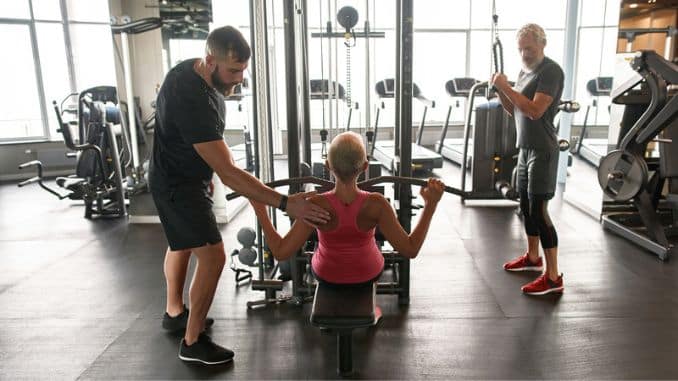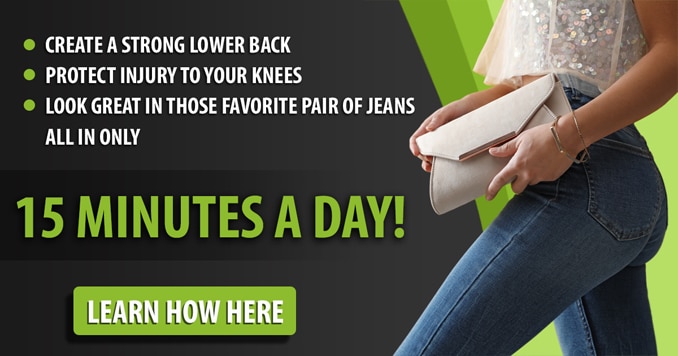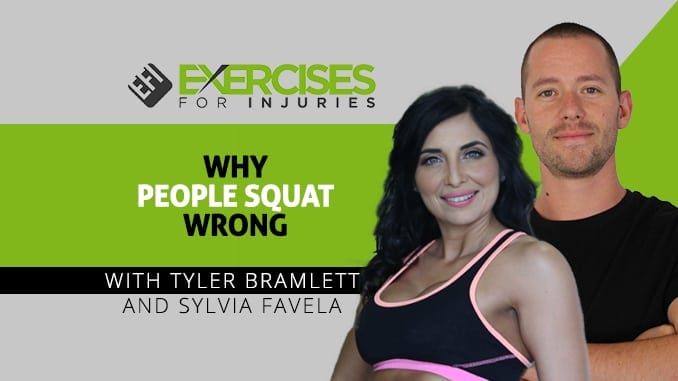
Today, I have another interview for you. And this is a three-way interview. So we will see how this goes and try it out. I have Sylvia and Tyler on the call. And I will get Sylvia to introduce herself to the listeners, viewers, and readers. This will include why people squat wrong.
Bodyweight Flows
Sylvia Favela: Hey guys, I am Sylvia Favela, the pilates chic at 360PilatesWorkout.com. I have been a Pilates expert for over a decade, helping people move and live better.
Rick Kaselj: Awesome. Okay, Tyler, I will get you to introduce yourself.
Tyler Bramlett: Hey guys, I am Tyler. I am just a normal guy who likes to train in his garage; that is what I do. I run GarageWarrior.com, and I love to teach people performance-based training. So that they can look good and perform even better.
Rick’s Kaselj: You two have teamed up to do something unique. And what you guys have combined to create these flows, these bodyweight flows.
Why Is It Beneficial For People?
Maybe you can talk about what a bodyweight flow is. And why it benefits people who add it to their programs.
Tyler Bramlett: Can I hit that one, Sylvia? Would you mind if I got that one?
Sylvia Favela: Go ahead!
Tyler Bramlett: I want to backtrack a little bit, Rick, to give people a perspective on why we thought about this product. Because that is important to understand that back story.
Many people these days might not be getting what they possibly could out of their workouts. What I mean by that is simple. They focus on reps, sets, and exercises. But they are not focusing on the real big picture, which is better movement.
I am sure you will agree with this. Because you have Exercises For Injuries. And you have to have good movement to prevent injuries. People out there focus more on the intensity and volume than on better movement. And we see this all the time, so I was onto this movement thing.
I focused on getting people moving better by doing warm-ups [¹] and performance training. Then literally about six months ago or four months ago, Sylvia and I were sitting down talking about this. We started talking about how we each individually teach people how to perform and move better. And through our talking, we were like, holy cow, we have the same philosophy and ideas. So why don’t we don’t together and come up with a concept so we can teach other people than just our clients how to do this kind of stuff?
So that is how our flow system originated. And if you guys are thinking of a flow right now and you are like, what the heck is that?
Simply put, you can think of it as a few exercises strung together very fluidly that teach people how to have a perfect form through those movements.

Workout Goal
Our goal is to simultaneously increase the range of motion, control of the muscles, and coordination. When people do that, their workouts instantly become better.
That is the goal of the system. Anything you would like to add to that, Sylvia?
Sylvia Favela: To be quite honest, you wrapped it all up in that one whole piece, but you nailed it with all that. The only thing I could add is, yes, it is moving better and just being more aware of what you are doing and how you are doing it and form and everything. That is like the missing key, the little aspect of fitness. Most people don’t even think about where you will get better by doing this.
Rick Kaselj: Awesome! Let us take a step back.
Importance Of Movement
What is this big deal about movement? Like people move around or people do exercise, like why should people shift over and start thinking about the movement side of things? They are already moving; they are doing stuff.
Sylvia Favela: Yes, they are moving, but they are very limited in their movement. Most people go about doing their workouts and just throwing things around. They will lift a weight and throw it around like, “Okay, y” ah maybe if I start feeling it burning after a hundred reps, then I have done something.”
Initially, you don’t have to do hundreds of reps to feel something more than you are targeting and hitting and activating those muscles [²]. As you move and know what you are doing, you can get better results, go further in your workouts, and get deeper into your workouts, if that makes any sense.
Tyler Bramlett: Yeah. The form is like a whole thing, Rick. We all talk about the form, like “Oh, my trainer told me to do this” or “I read this magazine, and it told me to do that.” But let me ask you this question, Rick, because you have trained many people who have had injuries, how many people do you see who come in and squat the first time correctly?
Rick Kaselj: Oh, a vast majority of why people squat wrong.
Tyler Continues: Horribly, it’s right? I watch kids unable to squat because they are watching their parents not being able to squat. And nine times out of 10, People Squat Wrong, they have one of three issues, which is what we are trying to address.
Three Issues Why People Squat Wrong Are:
- They can’t contract their muscles. They don’t understand what muscles they should be contracting. That generally has to do with the stability component, right?
- They lack range of motion or control over extreme ranges of motion. That means somebody might be able to do a parallel squat [³], but if they try to do a butt-to-ground squat, it’s never going to happen, or they will sacrifice their form because they lack the flexibility to do it.
- Coordination is shocking. Some people have flexibility and muscle strength but don’t know how to fire in a proper sequence. And how do you learn how to do that? You learn how to do that through movement training.
So we try to provide people with specific details that most trainers don’t understand, and it’s not their fault that they don’t understand. It’s just that Sylvia and I have been doing this for a long time, and both of us are obsessed with the fine points.
Sylvia comes from a therapeutic Pilates background, and I come, honestly, from my stack of injuries and then training other people to get past their injuries and then accelerate their performance. We are talking about better movement, which embodies learning how to move your entire body better. When people say “form,” it is thrown around loosely. And, as you know, we talked about the squat. People squat wrong. That is an easy example: somebody has a lousy squat during their workout, and somebody right next to them has a great squat. They do the same workout and the same reps; who are going to get a better result?
The person with the lousy form is not firing his muscles properly, not going through a whole range of motion, or the person firing their muscles properly, more explosively, more coordinated, and a full range of motion. They are going to burn more calories. They will burn more fat, gain more strength, and get better results with their workouts because they have access to them.
Rick Kaselj: Okay, we talked about the squat. What are some other movements that people mess up, that they have lost or haven’t learned properly?
SylviaFavelaa: Can I take that one?
Tyler Bramlett: Yeah, I will take that after you.
SylviaFavelaa: The one that is always messed up is the plank, a four-arm plank, a simple one. It is amazing, I have worked with so many people, and they will say, “Oh, yeah, I can do this,” and they go down like, “I can do this, I have been taught how to do this,” their lower back is arching, their head is in the wrong place. They are like, I can hold this, but all they are doing is injuring or putting more pressure where it is not needed. It’s frustrating because they will dive into their back.
Planking
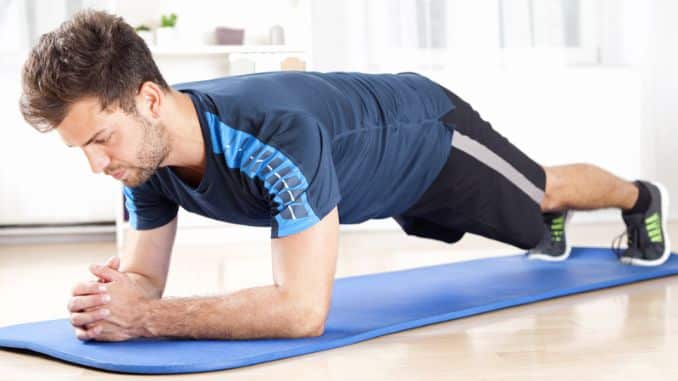
Plank is the number one movement I see that is done wrong.
Their form is off. The flows show you how to position your body in the correct spot to feel the core working quicker, and you don’t sacrifice having to use your back to get into that position holding it longer. So, which other exercises would you add, Tyler?
Tyler Bramlett: Well, I couldn’t’ t agree more on the plank, Sylvia, and one of the things that we try to do when we put together these bodyweight flows is not only create positions of stability, like the plank. It is to go into and out of the plank fluidly through other positions. Not only do we teach people how to do a basic plank, but I also don’t want anybody listening to this to think of it like we are just holding planks, right?
Maybe that would mean going from a plank where your stomach is facing the ground and then rotating around to the part where your body is facing the ceiling and then rotating back into the plank without sacrificing your core integrity.
We do a lot of rotational movements in this program. A lot of movements involve not just frontal plane stability or that lateral plane stability. We like to throw in a lot of transverse plane stability as well.
We do a lot of lower body movements. And a lot of planking movements. We do a lot of downward dog movements to increase mobility and teach stability in those positions. And string them together in these flows because that is what we know gets people firing their muscles properly, building more range of motion, and coordinating everything. So it is not just about holding a position properly. It is about the transition from one position to another.
One of the things that I’ve been teaching my Bootcamp clients for several years now is what I call neuro-reconditioning. Whenever you pick up or put down in class, you do it right and 100% right. So when you go home, and you drop your Kleenex on the ground and go to pick it up, you don’t throw your back out because I guarantee that when everybody throws their back out, it is never picking up something heavy.
It is always a little box or something like that. It is never picking up something heavy because when you pick something up heavy, you brace. Whether you know it or not, you lock everything down and brace. But when we want people to move better without having to think about it and start training their body through movement patterns, through positioning, through transitioning from position to position, what I feel was the best way to learn how to do it.
Rick’s Kaselj: Not everyone has access to a trainer or can have someone assess them.
Determining Poor Movement
What would you recommend to someone who is in that situation? How would they determine their poor movement and what they need to work on?
Tyler Bramlett: Oh, that is a great question. Would you mind if I jump in at the start there, Sylvia?
Sylvia Favela: Go ahead.
Tyler Bramlett: I am sorry, I am passionate about that topic. First of all, Rick, you are counting on finding one out of thousand people who would be able to follow along with just some of our flows and do them perfectly. It’s going to be a rarity that somebody presses play and is like, “Oh, I got this,” you know what I mean? And that is why when we designed the system that we put together, we did beginner, intermediate, and advanced variations.
The beginner flows with less control, less coordination, and a lesser range of motion than the advanced ones, which require a pretty extreme amount of flexibility, stability, coordination, and everything like that.
First, I am trying to say that everybody needs to work on this regardless of who they are. People Squat Wrong. If you are a professional athlete, you probably should be working on stuff to keep yourself injury-free, ensure your performance lasts longer, and so on. If you are brand new to training, you have got to work on this stuff because it will unlock your potential. It is going to unlock your physical potential.
Without thinking about who should be doing this because they have a bad form, I would say that everybody has got bad form on something, right? They have to learn how to move into and out of positions. And so how do they learn how to do a better form?
Like you said when talking about planks, the downward dog, and things like that, it would be great to hire a trainer if you could afford it. The harder part is if you can even find one qualified, which really, that one drives me crazy, we can talk all day about that.
Most of these people are not certified. They don’t know the first thing about muscular activation and proper positioning. Even if you could hire a trainer, it probably wouldn’t do you as much good as if you educated yourself. That’s the promise. We all empower others to teach us what we should and shouldn’t be doing when we should educate ourselves on how to move.
Movement Is The Key
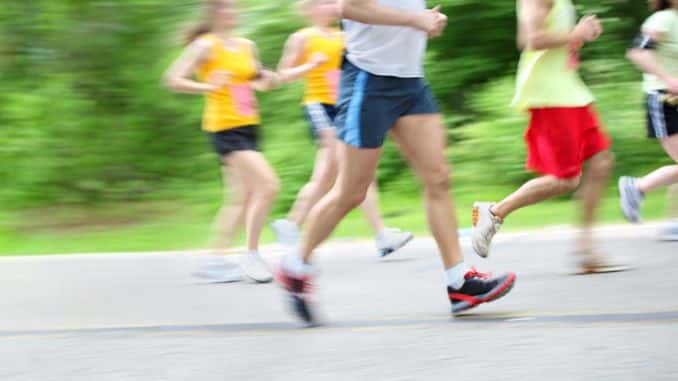
I am passionate about Rick because the neocortex’s brain was designed for better movement. It is supposed to help us expand and help our digits move so we can play pianos and build tools. That’s why it grew. And movement is the key; it drives me crazy.
When people move better, when they take some time to focus on movement rather than on how many push-ups and pull-ups and what not I can do, you are improving the functioning of your neocortex.
I know that didn’t answer your question specifically about trainers. I firmly believe that people who move better have a better connection to their brain, which also connects to other things, so there is so much benefit from it. Still, I try to tell people that everybody has some dysfunctions in moving, so everybody should work on their movement no matter what.
Rick Kaselj: Okay. One trend that has happened in fitness, which might be on the tail-end of the trend, is this thing called functional training, trying to take traditional bodybuilding exercises and tweak them so that they are functional or related to movements that one does in regular life.
Now, how do the bodyweight flows differ from functional training?
Tyler Bramlett: Oh, that is a good question. Do you want to tackle that, Sylvia?
Sylvia Favela: You are on a roll. Go on with it; I will jump in the right after you. Go right ahead
Tyler Bramlett: Okay, I will make this one a little briefer. I love the concept of functional training. It’s brilliant to think that you could train movement patterns that you perform daily so that your life improves, your body improves, and everything improves, right? I am a huge advocate of doing these things.
Where people go wrong with functional training is that they take it to an extreme that is useless, right? And so what I do within garage workouts, I do what is called real functional training.
R-E-A-L, real. It is an acronym for Realistic Exercises, which means things you might encounter in real life, not pink Barbie rotator cuff exercises with a band strapped around your knee on a BOSU ball. That is not ever going to happen.
Realistic exercises are executed with perfect form at a high intensity leaving you with a body that looks good and performs even better.
So that is my acronym for REAL functional training, and if you take it and apply it to an exercise, you will think, like, is this realistic? Can it be executed with perfect form? Can I do it at a high intensity? There are many woo-woo things you can’t do at a high intensity. You can’t do them at any level of intensity. They are like cross-eye therapeutic exercises.
To me, real functional training is learning how to squat on two legs, learning how to squat on one leg, learning how to rotate on the ground, learning how to stand up through rotational positions, learning how to stabilize yourself on the plank as you move in and out, some bridging, all these different things, that to me is real functional training. People Squat Wrong.
I see Rick just smiling under on the other end right there. That is what I think real functional training is, and People Squat Wrong people miss the boat on it, and they do so much stuff that is worthless that they never really end up getting any real results from it.
You have got to work on strength, you have got to work on intensity, and you have got to work on real movements. If you want to make them functional, do them in a way you might in real life. People squat wrong, but still, that specific adaptation to impose demands that we hear about all the time, the said principle that says that if I stand on a BOSU ball, I do the rotator cuff drills with the band strapped around my knee joints on a BOSU ball. All I am going to get better at is the Barbie dumbbell BOSU ball rotator cuff exercise. I am not getting better at anything else, right?
I like to make that point clear that you get better at what you practice, and if you practice flowing through movements you might get into in real life, you will get better at that. If you practice the pink Barbie BOSU thing, you will get better at that, but I don’t know how that will help you in the real world.
Sylvia Favela: This is why we planned it up to do this because I couldn’t even add anything more to that because that is exactly what I was about to say. In a realistic movement, and I mean that is not realistic, standing on a BOSU ball doing that. No one does that. It’s just doing real movements that you need from day to day.
Simple things like you are sitting down. If you are sitting on a bench watching your kids play, and you try to get up and turn around and grab something, you should be able to move easily, like, Oh, and you throw your back out. People squat wrong, so there are simple movements like that, which is what the flows do. They help you learn to move all together in transition from one move to the other. It’s just about the same thing as what Tyler was saying. It’s just realistic moves that you will do, not the Barbie rotation. That was pretty funny.
Rick Kaselj: We have to look for a YouTube video.
Tyler Bramlett: I should make you one. I will get the sweatband on and everything.
Okay, that is the end of part 1 of the interview. I will be back with part 2 later this week.
Unlock your full potential with Advanced Gluteus Maximus Exercises! Take your fitness to the next level by targeting your glutes for maximum strength, power, and definition. Don’t settle for ordinary—push beyond your limits and sculpt a stronger, more resilient body today! Start your journey to a better you with advanced glute training now!
Rick Kaselj, MS.
References
1.Williams, J. (2012). Warm-ups: what exactly are we trying to achieve? https://www.jenevorawilliams.com/wp-content/uploads/2012/10/Warm-ups-2.pdf
2. Kinugasa, R., Kawakami, Y., & Fukunaga, T. (2005). Muscle activation and its distribution within human triceps surae muscles. Journal of Applied Physiology, 99(3), 1149–1156. https://doi.org/10.1152/japplphysiol.01160.2004
3. A Comparison of Quadriceps Electromyographic Activity With. . . : The Journal of Strength & Conditioning Research. (n.d.). LWW. https://journals.lww.com/nsca-jscr/abstract/2000/11000/A_Comparison_of_Quadriceps_Electromyographic.2.aspx

